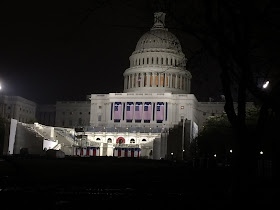At the recent 2017 Northeast/North Central joint section
meeting of the Geological Society of America, I ran into a thirty-something
alumnae of my undergraduate college who had finished her Ph.D. in geology in
2009. I first met this woman on a metamorphic-geology field trip several years
ago while she was still a grad student. It was great to see her again and catch
up. She told me she is STEM coordinator and adviser for a leadership scholars
program at a major university, but was apologetic that it was not a position actually
doing science. I said no apology needed! What a better adviser for students
considering STEM (science-technology-engineering-math) careers than someone who
has done science research and personally navigated undergraduate and graduate science
education?
This interaction also reminded me of grad school classmate
who, just before finishing her dissertation at what is a major research
institution, felt she was sensing disapproval from faculty for expressing an
interest in post-grad academic positions that focused mostly on teaching and
little on research. But there is not just one valid career path for persons
educated as scientists or engineers: teaching, research, advising/consulting, academic
or corporate leadership, public policy are among possible pathways, depending
on one’s talents, interests, and opportunities.
Teaching science includes a range of university
(post-secondary) positions from those at top-tier research institutions to
community and junior college. Research may be an essential part of many
university departments and a requirement for tenure; directing student research
is an important component. However, at institutions such as community colleges,
teaching may be the major or sole job requirement with limited opportunities
for one’s own or student research. However, that does not diminish the
important task of educating the students on the methodology of science, its
role in society, and the specifics of the science field chosen for a major or
distributive course requirement. In
addition, science education begins way before college: science subject K-12
teacher certifications start at the middle school level (~age 10), if not
before.
Careers that have science as a base, whether one has a
bachelor’s, Master’s, or Ph.D. degree in a science field, are numerous and
varied. Teaching is only one career line. Those who do research or applied science work for a
variety of institutions: academia, industry, government. Some scientists or engineers
in industry, as they advance their careers, may transition into a corporate
leadership track (example: Rex Tillerson, engineer and former CEO of
ExxonMobil). In academia and government, those who start in research and/or
teaching may choose to advance to institutional administration.
Scientists have also made career transitions into public
policy, working for non-profit science institutions, as staff for elected
representatives, or themselves holding elected or appointed government
leadership roles. In the US, Congressional Science Fellowship programs
sponsored by many professional scientific societies, under the oversight of AAAS,
is one avenue to participate in public policy for a year or a basis to make a
permanent transition into public policy. One could also apply directly for
Congressional staff jobs through the US Senate employment office
or the equivalent in the House of Representatives.
AAAS and some other scientific societies have fellowships in other government
agencies.
Science communication is a career path where a science
background is a plus. Some professional societies (American Geosciences Institute, AGI; American Geophysical Union, AGU; American Association for the Advancement of Science, AAAS) offer media internships or fellowships.
University schools of journalism, like at Columbia and Missouri, may have
concentrations in science and/or environmental writing.
It was recently pointed out in an opinion piece in the AAPG
Explorer (March 2017)
by AAPG (American Association of Petroleum Geologists) Executive Director David
Curtiss that General Colin Powell was an undergraduate geology major.
So don’t be ashamed of whatever career path you take after
getting a science degree! Your best contribution will be in a job that makes
you happy.
Below is a limited list of scientists who made career choices
where they eventually were not teaching science or doing research:
Rush Holt- physicist, former Congressman, CEO American
Association for the Advancement of Science (AAAS)
https://www.aaas.org/person/rush-d-holt
Andrew Rivkin- science and environmental journalist and author
(https://en.wikipedia.org/wiki/Andrew_Revkin; http://issues.org/32-2/my-climate-change/)
Andrew Rivkin- science and environmental journalist and author
(https://en.wikipedia.org/wiki/Andrew_Revkin; http://issues.org/32-2/my-climate-change/)
Harrison Schmidt- Geologist, Astronaut (Apollo 17), Senator
(1977-1983)
Joanne
Liu- President
of Doctors Without Borders/Médecins Sans Frontières (MSF),
Marcia McNutt, Director, US Geological Survey (2009-2013); President,
National Academy of Sciences
Melody
Brown Burkins- Congressional Science Fellow (1999-2000); US delegation chair,
2016 International Geologic Congress (IGC); Director for Programs and Research
of The John Sloan Dickey Center for International Understanding and Adjunct
Professor of Environmental Studies (ENVS), Dartmouth College
Steven Chu- Physicist, Nobel Prize winner, US Secretary of
Energy (2009-2013)
Ernest Moniz- Physicist, US Secretary of Energy (2013-2017)
Maria Honeycutt- Congressional Science Fellow (2007-2008),
Coastal hazards policy analyst (NOAA)
Kevin Wheeler- USAID, science and international development
consulting
David Curtiss- Congressional Science Fellow (2001-2002);
Executive Director, AAPG
Wendy Hill- Neuroscientist and Provost, Lafayette College
(to 2014); Head, Agnes Irwin School (private secondary school)
